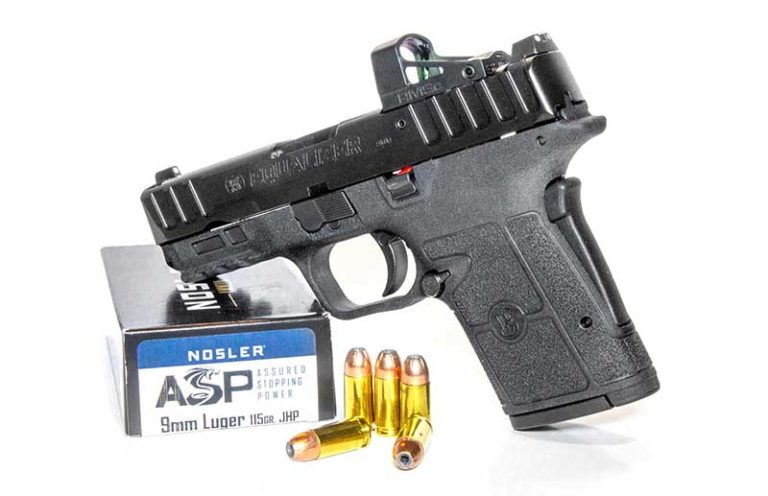
In this Smith & Wesson EQUALIZER review, the author takes a closer look at the company’s newest micro-9 carry pistol.
I was a bit shocked when I saw the announcement of the Equalizer pistol from Smith & Wesson. This is partly because Smith & Wesson already has a diverse collection of respected self-defense handguns. It’s also partly because just last year they launched a brand-new self-defense handgun called the CSX. But at the same time, this new pistol is just a perfect example of American gunmaking at its best. Smith & Wesson’s new Equalizer pistol epitomizes the refinement of design to best interface with customers.
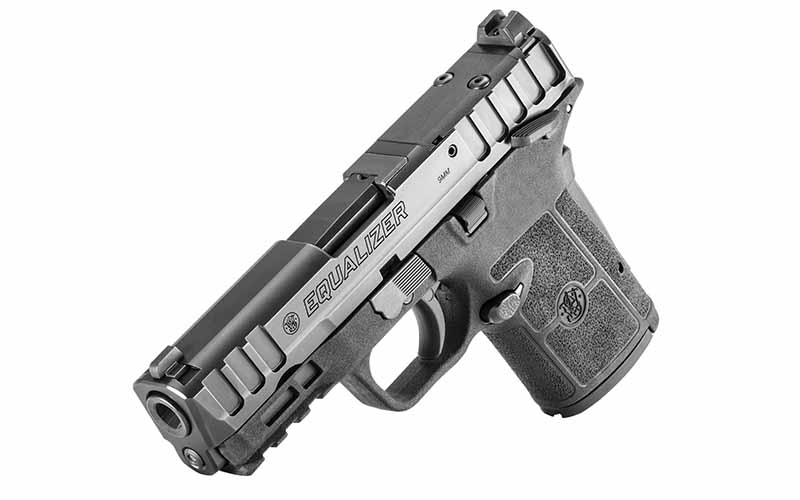
Smith & Wesson Equalizer Specs:
Action: Semi-automatic, single action (internal hammer)
Safety: Grip safety—SKU: 13592 (Ambidextrous thumb safety version—SKU: 13591)
Chambering: 9mm Luger
Barrel: 3.675 inches (Stainless steel with Armornite finish)
Slide: Stainless steel with Armornite finish
Sights: Steel with three white dots (cut for optics)
Frame: Black polymer
Capacity: 10+1, 13+1, 15+1 (Ships with three Shield-Plus compatible magazines)
Magazine Release: Reversible
Accessories: Maglula UpLula speedloader, gun lock, instruction manual
MSRP: $599
Notable Features
The Equalizer is a poly-framed, micro-compact, 9mm pistol. It resembles the M&P Shield EZ, but the Equalizer uses double as opposed to single-stack magazines. In fact, it uses S&W Shield Plus magazines. But unlike the Shield Plus, the Equalizer—like the Shield EZ—is a single-action as opposed to striker-fired pistol. Another difference is that the Equalizer is only available chambered for the 9mm Luger, where the Shield EZ can be had in .380 Auto, 9mm Luger and .30 Super Carry.
You’re probably wondering where—since this is a single-action—the hammer is. Well, this is technically a contained single-action; the hammer is hidden under the slide. At the bottom rear of the slide there’s a hollowed-out section that allows the hammer to rotate from the cocked to the fired position. Because of this, you don’t have the option of lowering the hammer manually, such as you would on a 1911. However, the firing mechanism is the same; when the gun is fired, the slide recoils to the rear and cocks the hammer. The hammer just stays cocked until you pull the trigger.
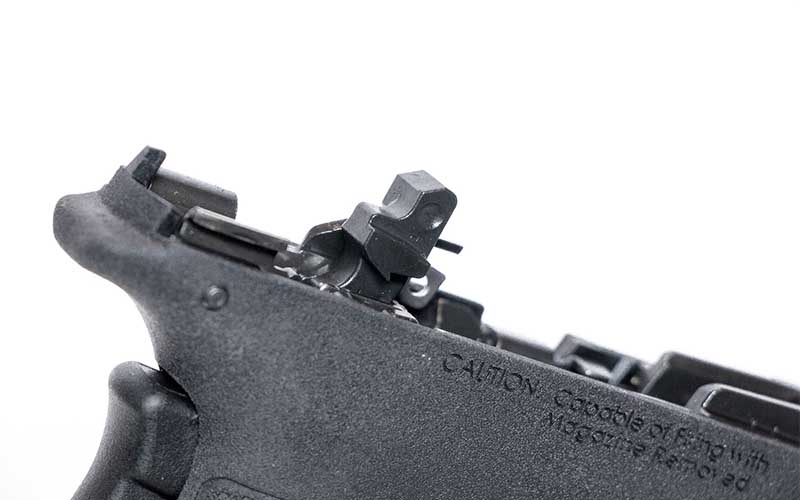
Smith & Wesson chose to include a grip safety on the Equalizer, and while I know some balk at the idea, and I’ll admit it does nothing to make this pistol attractive, it works to perfection. When shooting the Equalizer I gave it no notice at all. If you establish a good shooting grip on the gun, the grip safety deactivates. I tried to make it fail to deactivate by altering my grip and wasn’t successful unless I established a grip more than an inch below the pistol’s tang. The grip safety might make the Equalizer a bit ugly, but it’s a good design.
An ambidextrous thumb safety is available as an option. The test pistol didn’t have this feature. If it did, I might’ve written Smith & Wesson a check. I know, some folks don’t like thumb safeties, but they’re one of the best features available to make a handgun safer. Many self-inflicted gunshot wounds occur because shooters holster their handgun with their finger on the trigger. When doing so, the finger contacts the holster and presses the trigger, and a bullet ends up in the shooter’s ass cheek or leg. If a pistol is fitted with a manual thumb safety and if it is used as it is supposed to be this won’t happen.
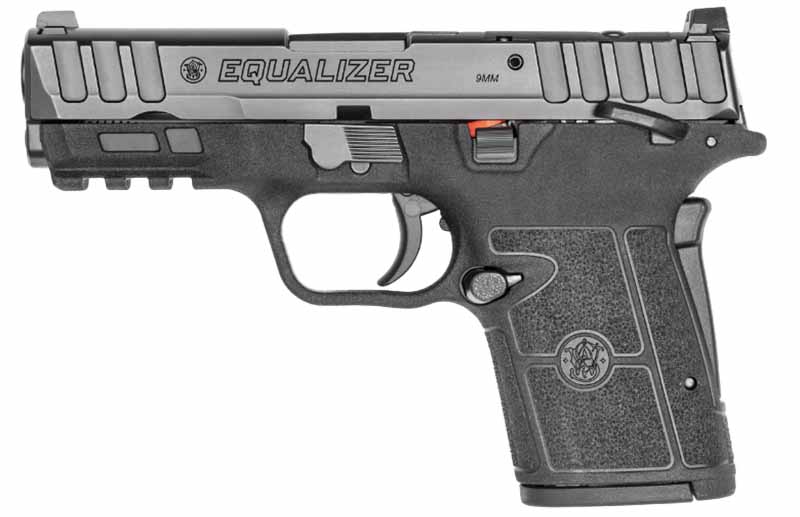
Safeties aside, the trigger on this pistol was very nice, much nicer than any factory—out of the box—striker-action pistol I’ve fired. It broke crisp and clean at 4.75 pounds. The trigger reset was audible but couldn’t be felt. Some might consider this a negative, but I fired more than 300 rounds out of this pistol running various, fast-action, multi-shot defensive drills and never did I short stroke the trigger with it failing to reach the reset. This trigger is good, way better than the trigger on the Smith & Wesson CSX pistols I’ve fired.
The slide on the Equalizer has a cutout and cover plate that makes it optics ready. The cutout is a bit large to interface with a wider range of reflex sights. I installed a Shield RMSc-4 MOA reflex sight, and the base on that unit was thin enough that I could still use the factory sights that come on the handgun. Smith & Wesson seems proud of the fact that these sights are steel, and they should be. They also seemed proud that they are of the three-dot variety. Though I know it has become the industry standard, I’m not a fan of three-dot sights. The good news is that finding aftermarket sights to fit this pistol shouldn’t be a problem.

The slide on this pistol also incorporates the Smith & Wesson next-gen EZ technology, making it easier to cycle. My wife and daughters all managed it with ease. Smith & Wesson also claims the Equalizer has a low recoil impulse. Recoil is a very subjective thing, but I’ll say I found the impulse to be less than some similar pistols like the Kimber Mako and the Taurus GX4. Others I suspect will have a differing opinion.
The slide also has very deep and aggressive cuts at the rear and front to help your fingers establish a purchase to manually cycle the slide. I don’t see much use for forward slide serrations; I like to keep my body parts away from a handgun’s muzzle. However, these deep cuts do help your fingers maintain hold of the slide when you need to rack it. Maybe more importantly, at the rear of the slide there’s sort of a ledge on each side to further help with manual cycling. This I found more advantageous than the deep serrations.

Weights And Measures
When it comes to carrying a pistol concealed, weight matters. The heavier the gun, the less comfortable it is to carry. This pistol, without a red-dot sight, weighs only 20.3 ounces. With the half-ounce Shield RMSc installed, total weight jumps to only 20.8 ounces. But, of course, no one carries a pistol unloaded. True carry weights must include a magazine and ammunition. With the 10-round magazine fully loaded, the pistol weighs 27.28 ounces. With the 13-round magazine, it weighs 28.95 ounces, and it weighs 30.01 ounces with the 15-round mag. All these weights were calculated with the half-ounce reflex sight installed and 115-grain ammunition.
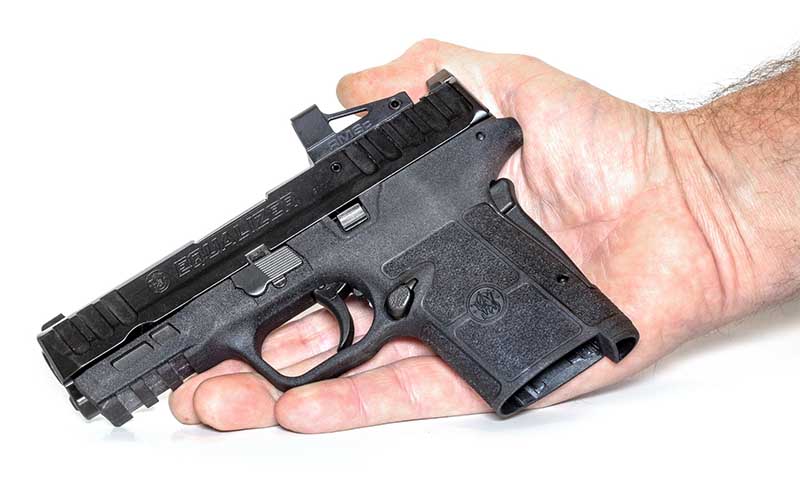
Of course, it’s not just about weight, size matters too. The Equalizer is only 6.9 inches long and just 4.5 inches tall. If you add a reflex sight, the height will extend to about 5.2 inches. Either way, that’s not much more than hand size. The flush-fit magazine adds nothing to the height, the 13-rounder about a half-inch and the 15-rounder about three-quarters of an inch. Though the slide-lock lever and the manual safety will add a bit to the overall width, this pistol is only an inch wide.
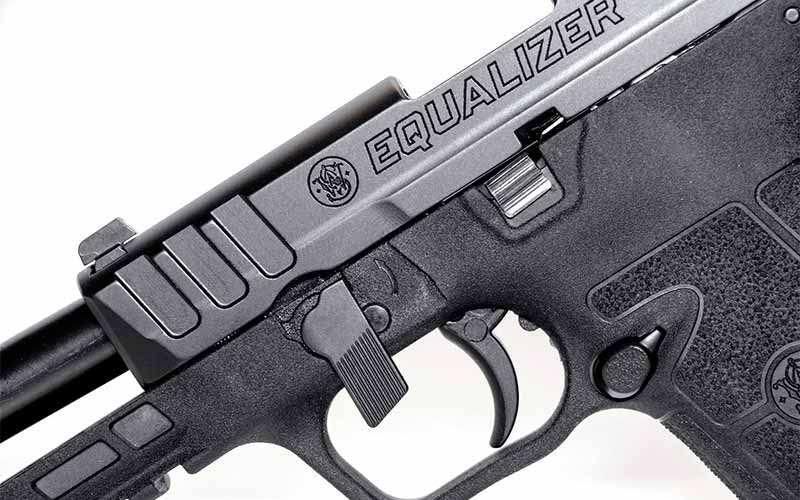
Shots Fired
From the bench at 10 yards, the Equalizer averaged right at an inch for five, five-shot groups with three different loads. This is better than average, especially from a less than 4-inch barrel. I also fired a single 15-shot group from the standing off-hand position at 10 yards using five rounds of the three test loads. That group measured right at 2 inches. Additionally, firing 10 shots at a half-size torso silhouette at 100 feet, I got all 10 hits in 11.74 seconds using the reflex sight. With the factory open sights, my time was 13.02 seconds, but I had one miss. Those 10-shot drills were timed and fired with a draw from concealment. If you cannot hit what you shoot at with this pistol, it won’t be the gun’s fault.
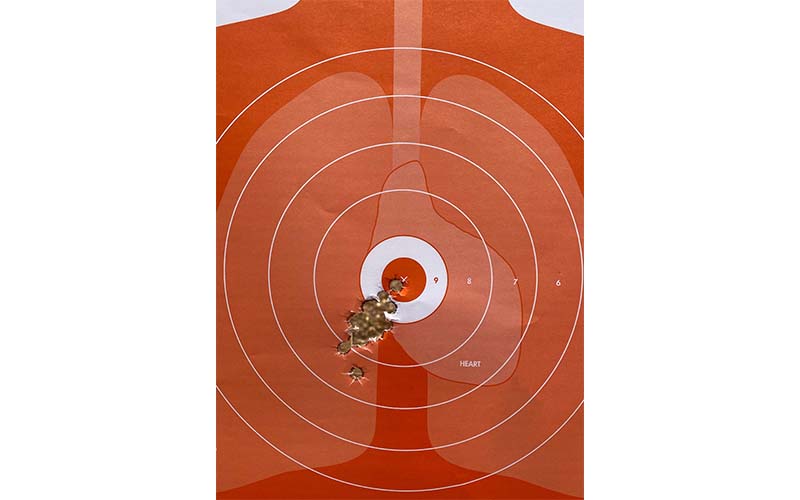
I also pushed 50 rounds through the Equalizer running my standard defensive handgun test drill—the Forty-Five Drill—with the goal of putting five shots inside a 5-inch circle, at 5 yards, in 5 seconds, from a concealed draw. My average time for 10 runs was 3.71 seconds. On two of the 10 runs I had one shot land outside the 5-inch circle. That’s similar to my normal performance with micro-9mm handguns. I will say that, as usual, I was on average about a third of a second slower when I used the reflex sight. For me to see a speed advantage with a reflex sight on a defensive handgun, I must stretch the distance to the target beyond 10 yards.
Shooting Results
| LOAD | MV | MD | SD | ME | PRECISION |
| Nosler 115-grain ASP | 1,005 fps | 26 fps | 11 fps | 258 ft-lb | 1.12 in. |
| Hornady 135-grain +P Critical Duty | 1,105 fps | 28 fps | 9 fps | 366 ft-lb | 0.97 in. |
| Federal 124-grain Hydra-Shok | 1,040 fps | 37 fps | 11 fps | 298 ft-lb | 1.02 in. |
| AVERAGE: 1.07 |
The Equalizer was very comfortable to shoot, and there were only two functionality issues. The seventh round out of the pistol failed to fully go into battery. It was a cartridge out of the 115-grain Nosler ASP box. I slapped the back of the slide, and the gun popped into battery and ran like a top after that. The other instance was an odd ammo issue with a single round of Federal 124-grain Hydra-Shok ammo. During the chronograph testing, it registered a muzzle velocity of only 447 fps. Yeah, I too would’ve thought the chronograph was on the fritz, but the recoil was noticeably less, and the empty case failed to eject. This cartridge must’ve been under charged from the factory, which is something I’ve never seen with Federal handgun ammo.
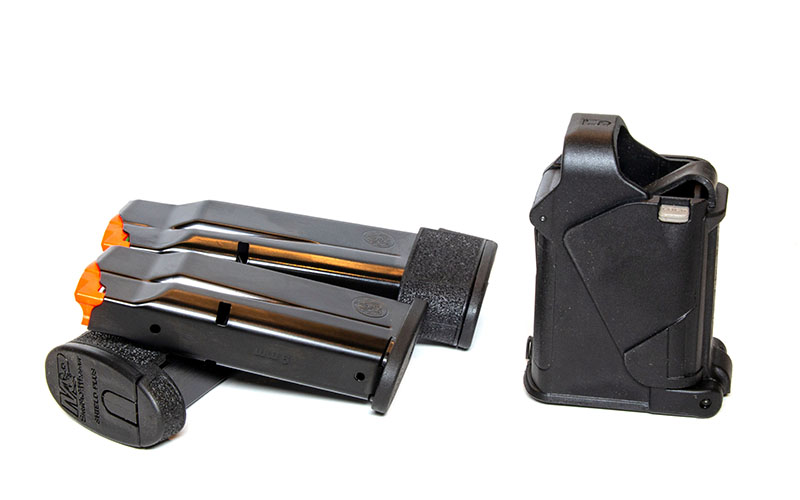
Final Thoughts
The fact this pistol comes with three magazines of varying capacities is appreciated, and they all worked to perfection. But I did experience a peculiarity. With the 15-round magazine, the pistol came up with the sights on the target from the draw. With the 13-round magazine, the sights were a tad high, and with the 10-round magazine, they were even higher. This was due to how my grip varied with the various magazines that extend the grip, and the extra pressure exerted on the grip by the pinky finger. You may not have this issue, but it’s something to be aware of. I’ve experienced it before with other micro-compact pistols with long and short magazines.
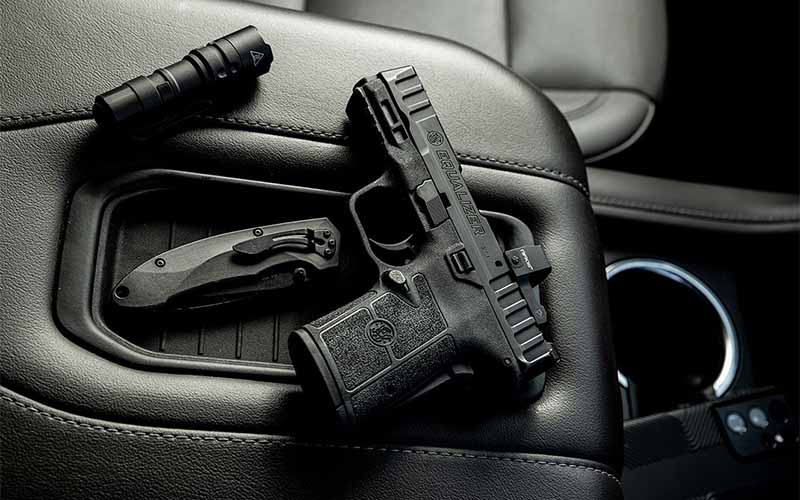
I like the Equalizer and believe I’d really like the version with the manual thumb safety. It’s compact, light, reliable, accurate, comfortable to shoot and easy to manipulate. I like it better than the S&W Shield, and way better than the CSX, which even costs a little more. What I’d really like to see is the Equalizer chambered for the .30 Super Carry. This should up capacity and make the gun even more comfortable to shoot.
Pros
- Reliable
- Small and lightweight, easy to carry
- Good ergonomics, very shootable
Cons
- The magazines with different sizes of finger extensions have the potential to affect your grip and create inconsistent presentations
Smith & Wesson Equalizer Deals
Editor's Note: This article originally appeared in the February 2023 issue of Gun Digest the Magazine.
More Handgun Reviews:
- The Big Snake Is Back: 2021 Colt Anaconda Review
- The Grand Puissance: Springfield SA-35 Review
- Shadow Systems MR920 Review
- Completely Customizable: Sig P320 Review
- Turkish Take On The Czech Classic: SAR 2000 Review

Next Step: Get your FREE Printable Target Pack
Enhance your shooting precision with our 62 MOA Targets, perfect for rifles and handguns. Crafted in collaboration with Storm Tactical for accuracy and versatility.
Subscribe to the Gun Digest email newsletter and get your downloadable target pack sent straight to your inbox. Stay updated with the latest firearms info in the industry.


![Best Concealed Carry Guns In 2025 [Field Tested] Wilson Combat EDC X9S 1](https://gundigest.com/wp-content/uploads/Wilson-Combat-EDC-X9S-1-324x160.jpg)


![Best 9mm Carbine: Affordable PCCs [Tested] Ruger Carbine Shooting](https://gundigest.com/wp-content/uploads/Ruger-Carbine-Shooting-100x70.jpg)
![Best AR-15: Top Options Available Today [Field Tested] Harrington and Richardson PSA XM177E2 feature](https://gundigest.com/wp-content/uploads/Harrington-and-Richardson-PSA-XM177E2-feature-100x70.jpg)

You didn’t try hard enough to get the grip safety to not compress fully. Fail is something different. Lay it on your nightstand or a table and then imagine someone just broke into your house and you get all excited. Now, grab that gun off the stand as quick as you would if this had really happened and see if your grip is proper enough to activate the grip safety. When testing it this way, I’ve found I fail to activate it way to often for me to use it as a self defense handgun. I wish S&W had found a better way.
As an old man with reduced strength and movement in my hands this gun is greatly appreciated. The grip safety and thumb safety work fine for me. I have always trained with single action and thumb safety. If anyone has trouble with this gun they should consider the EZ 380 with it’s smaller grip size and reduced recoil. For me revolvers a terrible for old hands. Long heavy trigger pull. Harsh recoil and short sight radius. Id be better off throwing it and running. Glad to see modern design come through!
As an NRA RSO working the range one day, a little old gal came by with one of these. She had small hands with arthritis, but a pretty good grip. However, she could not shoot this firearm. The backstrap safety gave her trouble. When she was able to overcome that, she would get one shot off and her knuckle would engage the thumb safety, making the firearm useless for her in a self-defense situation. I sent her back to the gun shop with the recommendation of a small frame revolver.
Jesus, you must either be a mornon or really hate that old lady. With arthritis so bad a grip safety casued her trouble you send her to get a handgun with an average trigger pull wieght of 12 pounds. Bravo! Give yourself another pin for your hat.
I’ve heard other women say they also had a problem at the range with the grip safety. As to the recommendation of the revolver, it all depends on the shooter and what their weakness are. If she can still handle and aim one well enough, all is well. She has to decide and I’d bet you let her try one of yours first. I’ve got rheumatoid arthritis and never know what part or joint will flare up next. Plus with age, our muscle strength decreases for many. The EZ would be great for me if not for that grip safety. there are other pistols that also have an easy slide to manipulate.